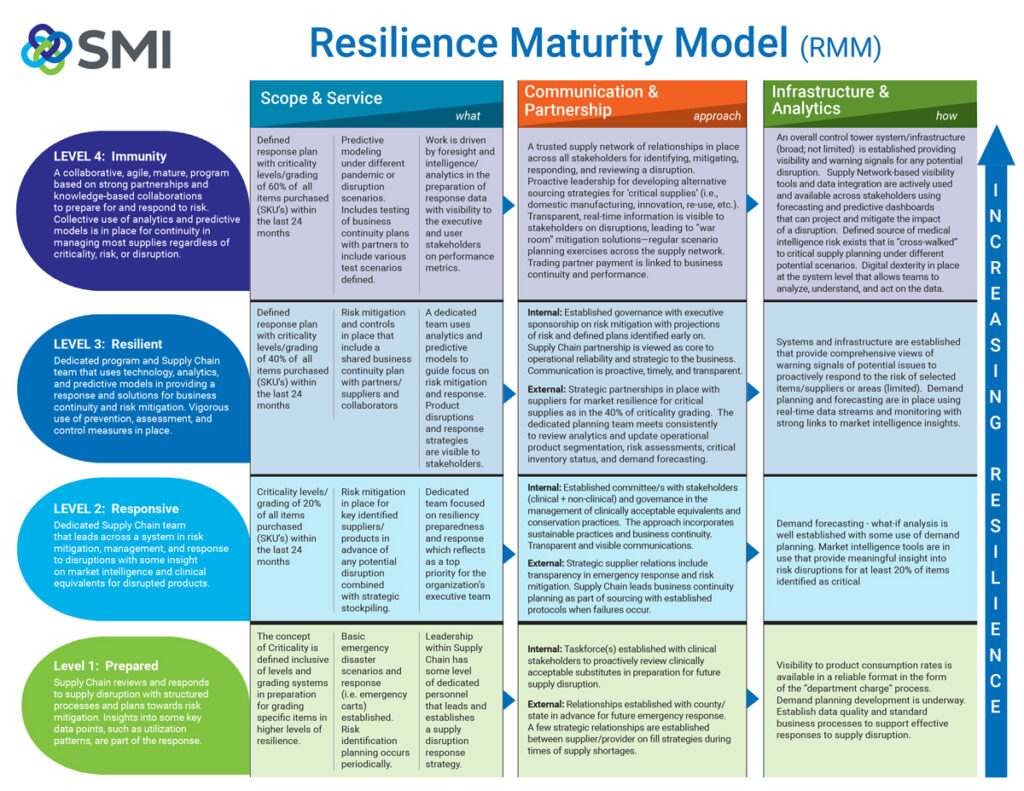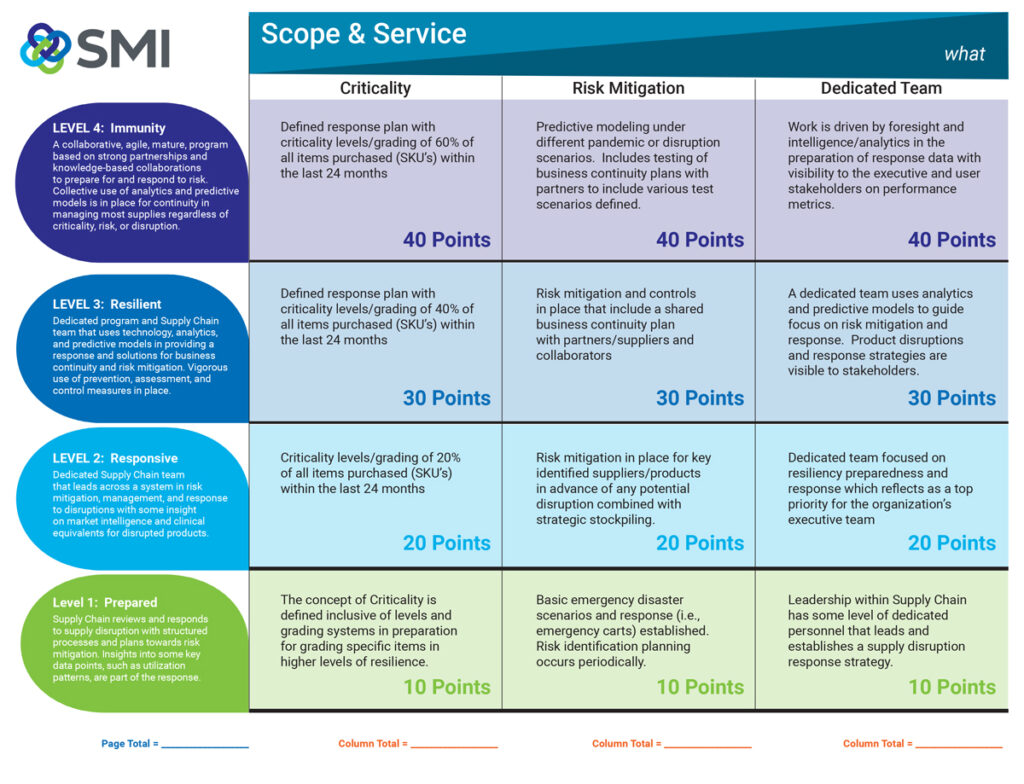SMI creates model, playbook to drive planning in healthcare.
October 2022 – The Journal of Healthcare Contracting
The Strategic Marketplace Initiative (SMI), a nonprofit, member-driven consortium of industry thought leaders in healthcare supply chain, released its Resiliency Maturity Model (RMM) and Playbook this year to help the industry be better prepared and mitigate risk for future potential disruptions. It incorporates core fundamentals of preparation, responsiveness and resiliency planning across the industry.

“We needed to understand how organizations were planning for resilience going forward,” said Nancy Anderson, Associate Executive Director of SMI.
SMI engaged with collaborators at North Carolina State University (N.C. State), including Rob Handfield, the Bank of America University Distinguished Professor of Operations and Supply Chain Management and Executive Director of Supply Chain Resource Cooperative. N.C. State students and the SMI team collected data and interviews that helped provide the critical structure to the new model.
“We work closely with several academics,” Anderson said. “These experts doing research are so valuable to us in the industry.”
The new RMM includes four key criticality levels that define the path towards optimal resilience.
- Level 1: Prepared
- Level 2: Responsive
- Level 3: Resilient
- Level 4: Collaborative Immunity
The model also defines three key elements that are critical to achieving each level of resilience, including Scope & Service, Communication & Partnership, and Infrastructure & Analytics. This RMM provides structure to organizations so they can develop their own Preparedness Playbook. It also includes a scoring mechanism that allows organizations to assess their own resilience status.
“Healthcare organizations, both providers and suppliers, can read the template and identify where they sit in each key element,” Anderson said. “We see this as an ongoing visual they can refer to as they go down their resilience journey.”
RMM Criticality Levels
- Level 1: Prepared. This includes establishing dedicated resources with an organization that are tasked with reviewing and responding to supply chain disruptions. Ideally, this involves establishing a cross-functional crisis response team to create and continually update contingency plans.
- Level 2: Responsive. Organizations on this level have invested heavily in human capital and technology resources that allow for committed time on risk mitigation, response and market intelligence in the response to and management of a disruption. A core element here that distinguishes this level of maturity is a dedicated team that operates across the organization to prevent impacts of disruptions.
- Level 3: Resilient. At this level, the dedicated team is more closely aligned with other business functions across the organization and in the use of technology, analytics and predictive models in providing business continuity. There are rigorous uses of prevention planning and controls on disruption in place that ensure continuity of core operations through any emergency.
- Level 4: Collaborative Immunity. This is an agile aspirational environment between suppliers, manufacturers, distributors and providers based on strong partnerships and knowledge-based collaborations in the response to risk. Collective use of analytics and predictive models are in place for continuity in managing most supplies regardless of criticality, risk or disruption.
“If we can provide a starting point and that infrastructure, we’re hoping we can jump start people on that resilience journey,” Anderson said. “I’d take this to my supplier meetings and say, ‘let’s talk about where we are on the journey – what are you all doing and where would you score yourself and where does that compare to where we are?’”
Scoring Mechanism and Getting Started
The RMM scoring mechanism allows organizations to assess their own resilience status so they can plan for next steps. With the goal of simplicity, points have been assigned for each maturity level across the key elements.

“This can create more awareness on the supplier side of what the customer is dealing with and hopefully reinforces the work they’re doing or gives them a different model of thinking about resilience,” Anderson said.
Anderson says SMI members are using the new RMM for their internal plans and embedding the information into their planning processes and documents. Others are sharing it and it’s an approach they are deliberating in respect to their resiliency plans.
RMM includes five steps for an organization to get started on building a resiliency plan.
1. Form a team. This includes people from security operations, emergency management, supply chain management, inventory and warehouse management, IT, with ad-hoc departments from legal, finance, audit, to quality and patient safety.
2. Set an objective. This a goal to initially pull together the right inventory and material data and begin to identify what they mean by “critical products.”
3. Develop contingency plans. This is for single-source items. Develop risk mitigation plans for key identified suppliers/products disruption with strategic stockpiling.
4. Consider forming an ongoing risk analysis/market intelligence team. This is to keep aware of events that could impact supply of critical healthcare items.
5. Build a playbook. This identifies roles and responsibilities for future events.
SMI Team Leaders
Team leaders for SMI include Amanda Chawla, Chief Supply Chain Officer at Stanford Health Care, and Alan Mavis, Director, Integrated Delivery Networks at Baxter. They guided more than
40 SMI members and collaborators in creating this RMM tool to support healthcare organizations regardless of their resilience journey.
“Amanda and Alan will lead our resiliency and transparency work going forward at least through 2023,” Anderson said. “A two-person team leads all of our Thought Leadership Councils, including one provider and one supplier.”
SMI’s Thought Leadership Councils focus on specific topics that SMI members consider essential for creating a leading-edge, cohesive, resilient and collaborative healthcare supply chain from manufacture to point of care. Chawla and Mavis lead the Resilience and Transparency Council.
SMI has established four Thought Leadership Councils to provide direction and insight to SMI, its members and the industry on targeted issues in healthcare. They include Clinical Integration, Collaboration, Diversity and Inclusion, and Resilience and Transparency.
The RMM and Playbook can be downloaded from the SMI website, www.smisupplychain.com/tools.
